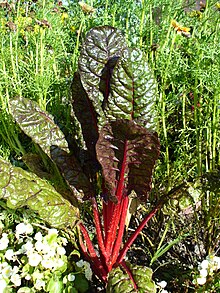Swiss Chard
| Chard | |
|---|---|

Chard
|
|
| Species | Beta vulgaris |
| Subspecies | Beta vulgaris subsp. vulgaris |
| Cultivar group | Cicla Group, Flavescens Group |
| Origin | Sea beet (Beta vulgaris subsp. maritima) |
| Cultivar group members | Many; see text. |
| Nutritional value per 100 g (3.5 oz) | |
|---|---|
| Energy | 84 kJ (20 kcal) |
|
4.13 g
|
|
| Sugars | 1.1 g |
| Dietary fiber | 2.1 g |
|
0.08 g
|
|
|
1.88 g
|
|
| Vitamins | |
| Vitamin A equiv. |
(38%)
306 μg
(34%)
3652 μg11015 μg
|
| Vitamin A | 6124 IU |
| Thiamine (B1) |
(3%)
0.034 mg |
| Riboflavin (B2) |
(7%)
0.086 mg |
| Niacin (B3) |
(2%)
0.36 mg |
| Pantothenic acid (B5) |
(3%)
0.163 mg |
| Vitamin B6 |
(7%)
0.085 mg |
| Folate (B9) |
(2%)
9 μg |
| Choline |
(6%)
28.7 mg |
| Vitamin C |
(22%)
18 mg |
| Vitamin E |
(13%)
1.89 mg |
| Vitamin K |
(312%)
327.3 μg |
| Minerals | |
| Calcium |
(6%)
58 mg |
| Iron |
(17%)
2.26 mg |
| Magnesium |
(24%)
86 mg |
| Manganese |
(16%)
0.334 mg |
| Phosphorus |
(5%)
33 mg |
| Potassium |
(12%)
549 mg |
| Sodium |
(12%)
179 mg |
| Zinc |
(3%)
0.33 mg |
| Other constituents | |
| Water | 92.65 g |
|
|
|
|
|
| Percentages are roughly approximated using US recommendations for adults. | |
Chard (Beta vulgaris subsp. vulgaris, Cicla-Group and Flavescens-Group) is a leafy green vegetable often used in Mediterranean cooking. In the Flavescens-Group-cultivars, the leaf stalks are large and are often prepared separately from the leaf blade. The leaf blade can be green or reddish in color; the leaf stalks also vary in color, usually white, yellow, or red. Chard has highly nutritious leaves making it a popular addition to healthful diets (like other green leafy vegetables). Chard has been around for centuries, but because of its similarity to other beets and some other vegetables such as cardoon, the common names used by cooks over the centuries may be confusing.
Chard was first described in 1753 by Carl von Linné as Beta vulgaris var. cicla. Its taxonomic rank has changed many times, so it was treated as a subspecies, convariety or variety of Beta vulgaris. (Some of the numerous synonyms are Beta vulgaris subsp. cicla (L.) W.D.J. Koch (Cicla Group), B. vulgaris subsp. cicla (L.) W.D.J. Koch var. cicla L., B. vulgaris var. cycla (L.) Ulrich, B. vulgaris subsp. vulgaris (Leaf Beet Group), B. vulgaris subsp. vulgaris (Spinach Beet Group), B. vulgaris subsp. cicla (L.) W.D.J. Koch (Flavescens Group), B. vulgaris subsp. cicla (L.) W.D.J. Koch var. flavescens (Lam.) DC., B. vulgaris L. subsp. vulgaris (Leaf Beet Group), B. vulgaris subsp. vulgaris (Swiss Chard Group)). The accepted name for all beet cultivars, like chard, sugar beet and beetroot, is Beta vulgaris subsp. vulgaris. They are cultivated descendants of the sea beet, Beta vulgaris subsp. maritima. Chard belongs to the chenopods, which are now mostly included in the family Amaranthaceae (sensu lato).
...
Wikipedia
